Atlantic on the move
As Los Angeles' boulevards reassert their place in the public realm, the transformation along Atlantic offers glimpses of a new city identity taking shape.
Click the blue mile markers above — or use the arrows — to take Christopher Hawthorne's guided tour of key sites along Atlantic Boulevard.
May 13, 2012
The 5600 block of Atlantic Avenue doesn't look like much at first glance, especially if you're zipping through at 45 mph. A dry cleaner, a pupuseria, a T-shirt shop and a medical marijuana dispensary line the low-rise street in the North Village Annex section of Long Beach. About a third of the storefronts are vacant.
But if you climb out of the car, you'll notice that this classic commercial strip — convenient for drivers, charmless and alienating for everybody else — is in the midst of a remarkable evolution.
A crosswalk cuts across the boulevard at mid-block, complete with a flashing signal for pedestrians. Orange and blue bike racks dot the sidewalks. Silk floss trees, lined up in a neat row along the median, frame a piece of tiled public art.
And the Brandon Bike Shop, which opened earlier this year behind a nondescript storefront at 5634 Atlantic, buzzes with activity. On a recent afternoon, Rodolfo Alcantara, a 19-year-old with a white stud in his lip, was working the counter while "Faded," by the rapper Tyga, thumped from speakers behind him.
He said the store caters to the growing number of teenagers and twentysomethings in the neighborhood, including him, who've become obsessed with riding and detailing their bikes.
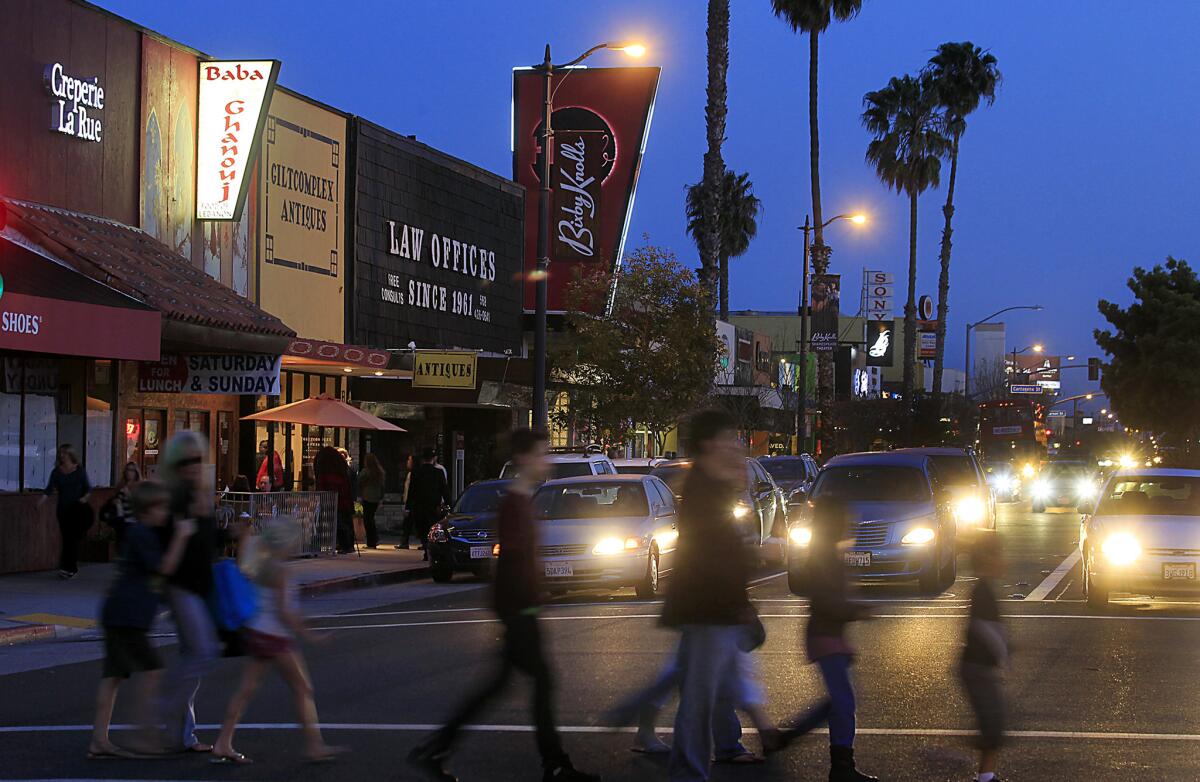
Pedestrians stroll along Atlantic in Bixby Knolls during the latest of the Long Beach neighborhood's monthly "First Fridays" art walks. (Luis Sinco / Los Angeles Times) More photos
"It's the new style," Alcantara said.
The changes along Atlantic are emblematic of the way urban planners, architects, shopkeepers and neighborhood activists are remaking the boulevards of Southern California, reversing decades of neglect.
The boulevard, in fact, is where the Los Angeles of the immediate future is taking shape. No longer a mere corridor to move cars, it is where L.A. is trying on a fully post-suburban identity for the first time, building denser residential neighborhoods and adding new amenities for cyclists and pedestrians.
In the process, the city is beginning to shed its reputation as a place where the automobile is king — or at least where its reign goes unchallenged. Cities across the U.S. followed L.A.'s car-crazy lead in the postwar era. This time around we might provide a more enlightened example: how to retrofit a massive region for a future that is less auto-centric.
Especially among younger Angelenos, including foreign-born immigrants and transplants from other American cities, there is a hunger for better-designed roadways and new ways of getting around. And L.A.'s political leadership is finally responding.
The biggest single change is the appearance of new transit lines. Flush with cash from the Measure R sales-tax increase, which is expected to raise $40 billion over 30 years, the Metropolitan Transportation Authority is extending subway, light-rail and bus networks across L.A. County, including the new $930-million Expo Line.
In addition, the city of Los Angeles is updating its basic transportation framework for the first time since 1999. It is adding more than 1,600 miles of bike lanes, backing an ambitious bike-share program and planning to hire a pair of full-time "pedestrian coordinators."
Smaller-scale and bottom-up initiatives — pedestrian plazas, food trucks, guerrilla gardening on long-forsaken medians — are also bringing new urban energy to dozens of major streets.
That transformation is the focus of a series of stories that begins with this look at Atlantic, which carves a long, gently meandering path along the eastern outskirts of Los Angeles, from Alhambra south all the way to Long Beach.
"Boulevard," which comes to us from the French, shares its roots with the word "bulwark," a barricade or protective wall. In Los Angeles the boulevards have had the opposite effect, not dividing the city but stitching it together, providing a loose super-grid for the vast region.
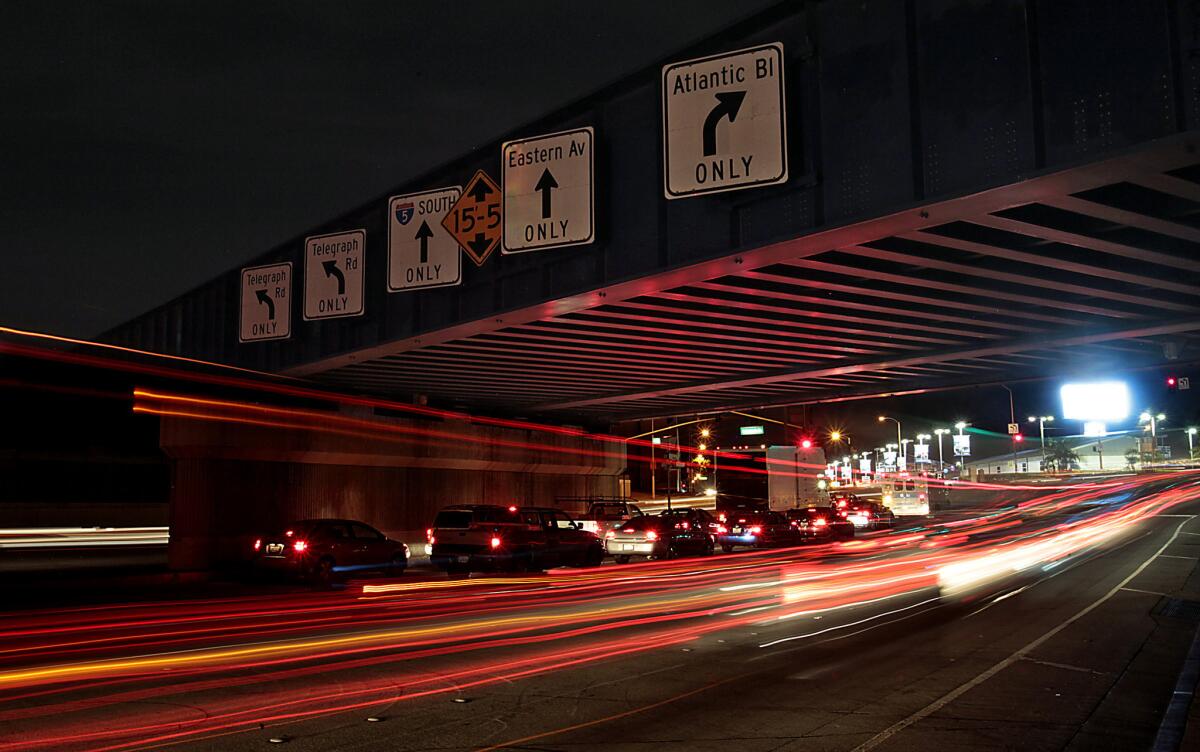
In Commerce, the junction of Atlantic Boulevard, Telegraph Road and Eastern Avenue is very much an auto-centric roadway. (Luis Sinco / Los Angeles Times) More photos
The boulevard is the only part of the built environment in Southern California that operates simultaneously at local and regional scale. It defines the neighborhood block even as it gives sprawl a spine.
Most major boulevards in Los Angeles follow a route that represents, in essence, a series of negotiations between geography, politics and real estate. A few of the best-known boulevards trace the edges of the old Spanish and Mexican ranchos for some of their length. Others emerged as key thoroughfares later on, following the 1924 "Major Traffic Street Plan for Los Angeles," developed by the landscape architects Frederick Law Olmsted Jr. (son of the famed Central Park designer) and Harland Bartholomew.
For the last several decades, the boulevards have operated in the shadow of the freeway.
Built mostly between 1940 and '75, the L.A. freeway system ranks among the most audacious infrastructural achievements in American history. But a freeway is the antithesis of rich and layered urbanism. It offers a monoculture, a space ruthlessly designed so that one activity, and only one, can take place there.
What's more, in the process of building the freeway network we became so enamored of the speed and freedom offered by frictionless driving that we overreached. We allowed traffic engineers to reshape our boulevards to make them as much like freeways as possible: adding lanes, raising speed limits and otherwise giving motorists priority over everyone else.
But the boulevards have begun to reassert themselves as places where the whole messy range of urban life has room to play out. Much of the credit goes not to planners or architects but to neighborhood and community activists.
The CicLAvia festival, which on four Sundays over the last two years has closed several miles of streets to cars in favor of bike and foot traffic, has been painstakingly nurtured toward official status by its founders, Aaron Paley, president of the L.A. nonprofit Community Art Resources, and bike activist Joe Linton. Along Colorado Boulevard in Eagle Rock, a group of residents, frustrated by the way speeding cars dominate the six-lane corridor, created a group called Take Back the Boulevard in hopes of redesigning the street.
The sheer scale of L.A.'s major boulevards makes improvements along their length piecemeal and hard-won. Atlantic is 25 miles long, roughly twice the length of Manhattan.
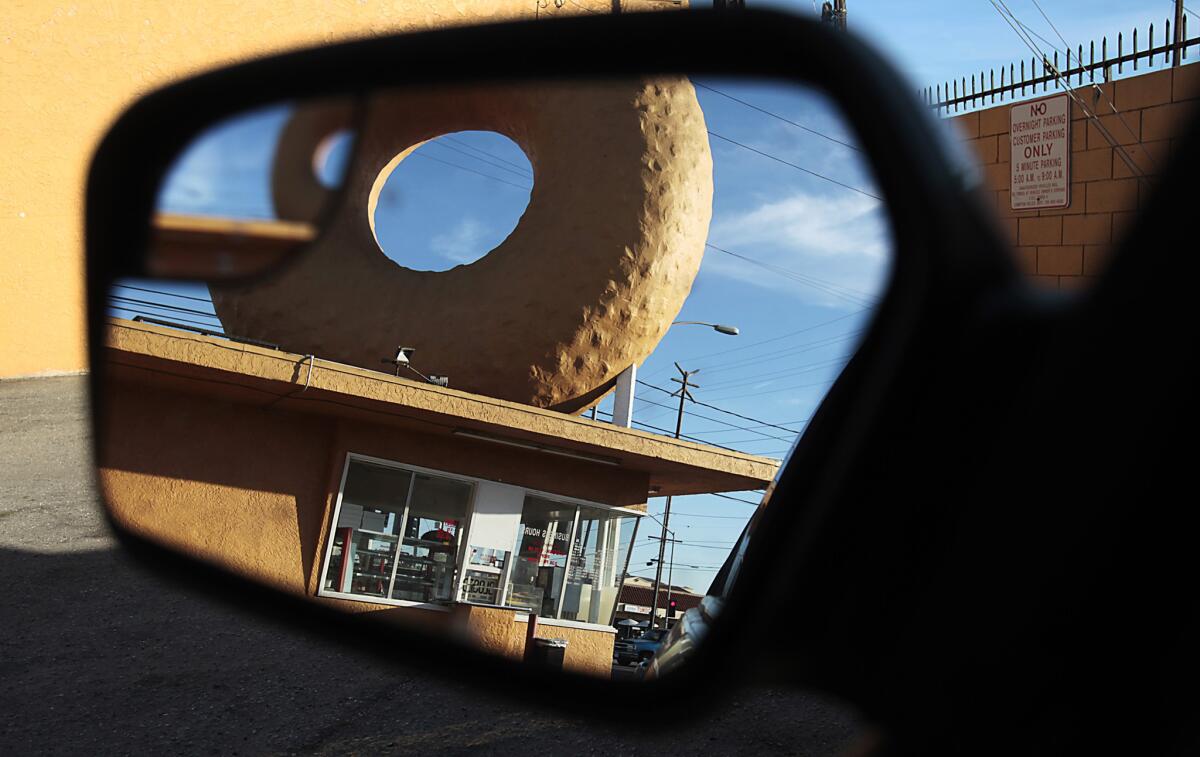
Dale's Donuts, located on the southeastern corner of Atlantic Boulevard and Alondra Boulevard in Compton. (Luis Sinco / Los Angeles Times) More photos
And even as more Southern Californians embrace walking and bicycling, they are finding that cities have allowed streets and especially sidewalks to crumble in recent decades. Not just in L.A. but across the U.S. we've neglected the simple act of walking for so long that we now face a patently absurd task: redesigning our streets, often at significant cost, just to make it possible for citizens to put one foot in front of the other without feeling unwelcome, unsafe or a bit eccentric.
Along Atlantic, officially a boulevard along its northern stretches and an avenue further south, the dominant architecture reflects a region still in thrall to automobiles and petroleum. Its most recognizable landmarks — Dale's Donuts in Compton, for example, whose doughnut-shaped rooftop sign is nearly twice as tall as the building itself -- are designed to be glimpsed through a windshield.
Yet as I made nearly a dozen trips along Atlantic in recent weeks -- on foot, on a bike, on a bus and in a car — what struck me was not stasis but change. The classic drive-through architecture of the Southern California strip, though a whole lot of it remains, is slowly making way for a new, more public cityscape.
The taco trucks that appear at night along Atlantic as it runs through East Rancho Dominguez have transformed the way pedestrians use the sidewalks. By creating instant storefronts facing away from the boulevard, the trucks produce temporary pockets of human-scaled, even intimate public space.
New construction on Atlantic is much more likely to be built right along the boulevard than behind a massive parking lot, as existing buildings tend to be. The Kipp Raices Academy, a 2-year-old charter school in East Los Angeles painted in various shades of green and gray, comes right out to the sidewalk. So does a Vons supermarket in downtown Long Beach recently remodeled by KKE Architects.
So, with decidedly uneven architectural results, does the massive new Atlantic Times Square development in Monterey Park, which combines ground-floor shops and restaurants with 210 condos on its upper floors. It attempts to bring together the street-front energy of nearby Valley Boulevard in Alhambra, with its noodle shops and cacophony of signs in Chinese, and the upscale residential amenities and flashy lighting of Rick Caruso's Americana at Brand complex in Glendale.
It is not a happy marriage.
Three miles south of Monterey Park, by contrast, the arrival of light-rail in the form of the Metro Gold Line has been a boon for Atlantic, enlivening the boulevard for several blocks in every direction. Late one afternoon I rode the train from downtown L.A. through Boyle Heights; at the Atlantic station, terminus of the route's 2009 $898-million Eastside extension, I disembarked along with 45 or 50 others.
About a third of the passengers headed west on the platform, away from Atlantic, but the rest of us walked east and blended into the pedestrian crowd along the boulevard. Many headed directly for a Metro bus stop at the corner of Atlantic and Pomona Boulevard.
Like a depressing number of bus stops in Southern California, this one backs up directly to a fast-food drive-through, in this case McDonald's. Because transit planners and fast-food restaurants both covet corner locations, this juxtaposition is increasingly common around the country.
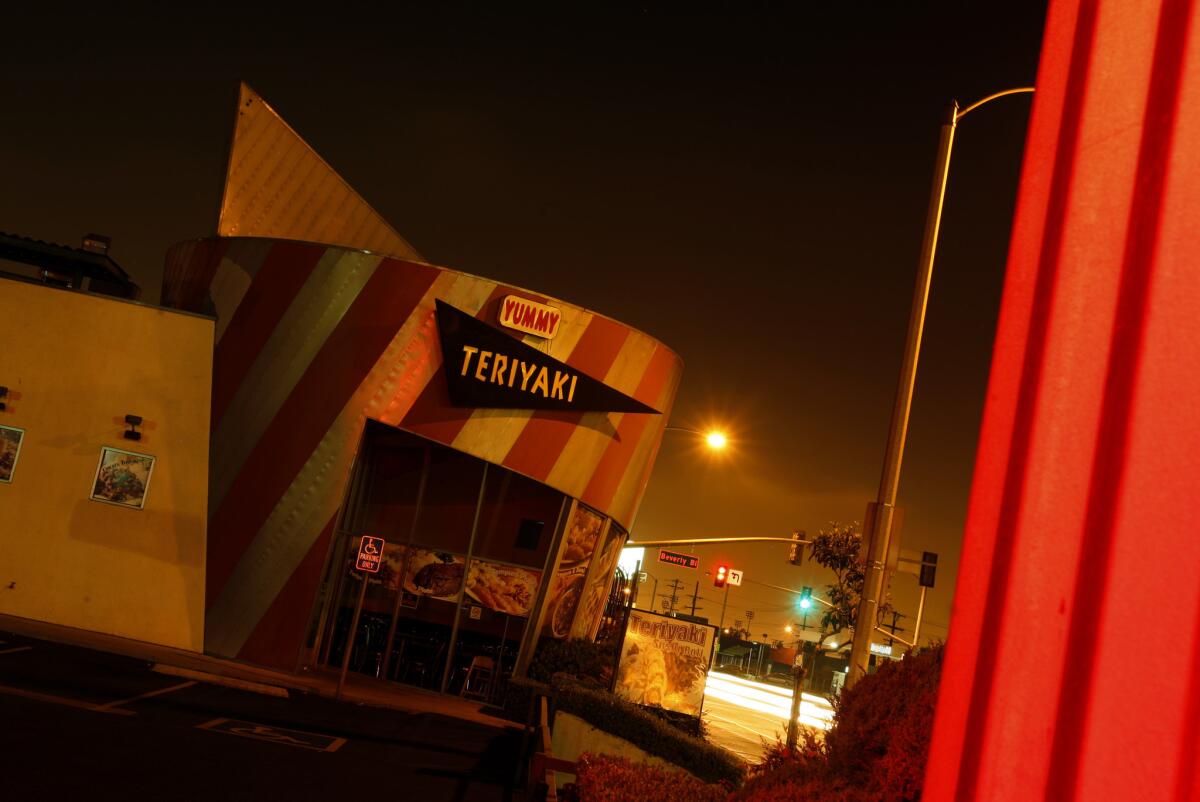
Yummy Teriyaki, at the corner of Atlantic and Beverly boulevards in East L.A., takes its design cues from the '80s L.A. School architecture. (Luis Sinco / Los Angeles Times) More photos
The panorama I could see from the bus stop, on the other hand, practically screamed "L.A." I watched cars race by on a nearby elevated section of the 60 Freeway. Behind that were the snow-capped San Gabriel Mountains. Across Atlantic stood a Pep Boys outlet occupying a white, vaguely Art Deco building with a tall, mast-like sign marking the corner. A few doors south was Yummy Teriyaki, a cylindrical building that takes its design cues — including angular strips of metal — from the hard-edged L.A. School architecture of the 1980s.
Selling teriyaki in a Latino neighborhood inside a Frank Gehry knockoff? Only in Southern California.
A few feet away, Jessica Rodriguez, 18, and her friend Marcos Garcia, 15, were waiting to cross the street to get to the Gold Line station. They were both wearing Tom's shoes, snug untucked Oxford shirts and skinny jeans.
Each was holding an iPhone, and they obligingly removed their ear buds to answer a few questions. They told me they'd taken the bus north along Atlantic from Bell, where they live, and hopped off in front of Pep Boys. They were planning to take the Gold Line west to Boyle Heights.
The train, Rodriguez said, is faster than the bus, and safer.
When I asked her how they got to Boyle Heights before the light-rail line was built, she looked puzzled.
"What do you mean?" she asked. It was as if she could barely remember life without that option.
"Oh, OK. Two Metro buses. All the way through HP," Rodriguez said, referring to Huntington Park.
Her generation — the so-called millennials — is more receptive to public transit than their parents, research shows.
That may be due in part to their nearly umbilical attachment to smartphones, which make it easier than ever to plan a trip on public transit. Phones can tell you when the next bus is coming, the best place to transfer and where to get a good cup of coffee once you've arrived. And you don't have to put them down while riding a train, as you do when you're driving a car.
On another afternoon, I drove the length of Atlantic with Douglas Suisman, an architect and urban-design consultant who works in Santa Monica. His concise and shamefully underappreciated 1989 study of the history and design of the boulevards — "Los Angeles Boulevard: Eight X-Rays of the Body Public" — remains the most important take on this gigantic subject.
Suisman was writing at a time of deep pessimism about Los Angeles civic life, and he lamented efforts by architects and developers "to bypass a public realm which most suburbanites are presumed to fear." The view was even darker in Mike Davis' hugely influential 1990 "City of Quartz," which cataloged "the destruction of accessible public space" in Southern California and labeled L.A. a "fortress city."
But the fortress is showing some cracks. During our drive, Suisman noted how technology and new kinds of mobility are making a mark along Atlantic.
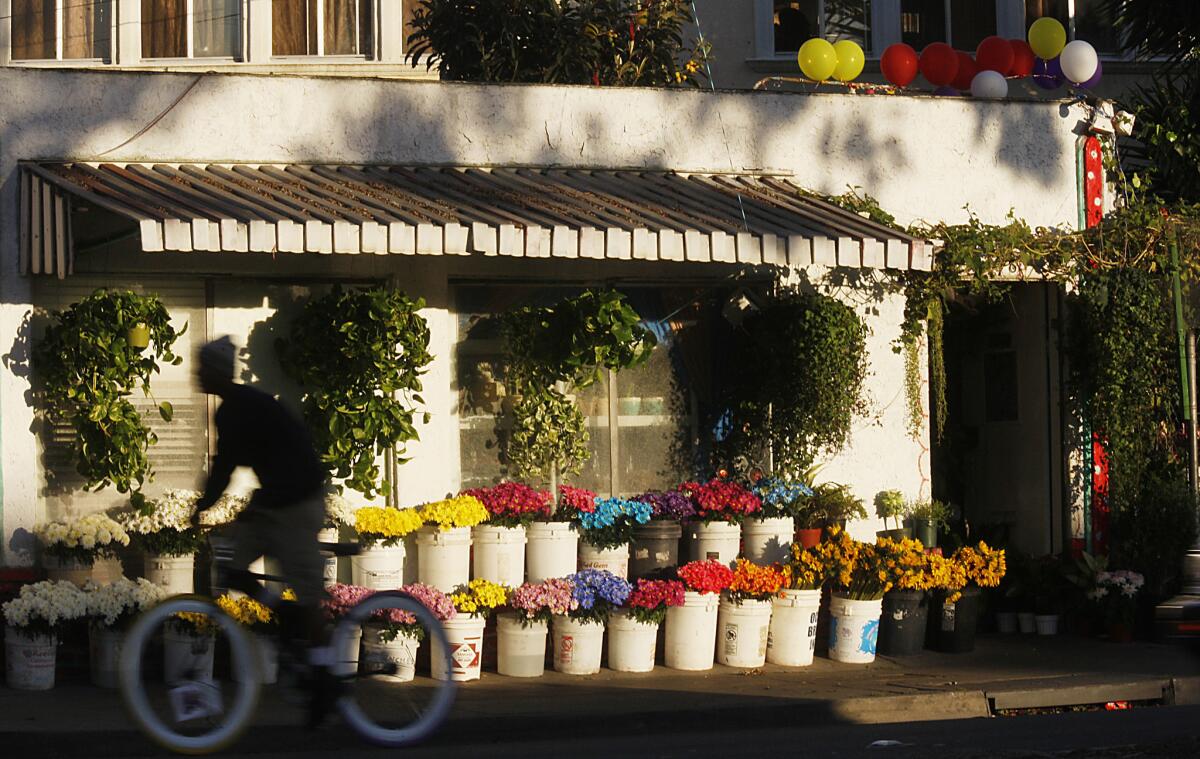
A Long Beach flower shop provides a burst of fresh color on the 5300 block of Atlantic. (Luis Sinco / Los Angeles Times) More photos
In Long Beach, especially, signs of a boulevard reconnecting with the public realm — and providing fresh reasons for people to climb out of their cars — were impossible to miss. The city of 460,000 has adopted a new motto: "The Most Bicycle Friendly City in America." It has spent $20 million on bike lanes and other cycling programs.
In the Bixby Knolls neighborhood, just north of the 405 Freeway, a new initiative allows residents to walk or bike to the Trader Joe's market on Atlantic and have their groceries delivered free — by couriers who are also on bikes. Further south, Suisman noted the electronic tickers above several bus stops, powered by solar panels and announcing when the next few buses would arrive.
"That's getting up there to San Francisco and Portland levels of sophistication," he said admiringly.
A few weeks later, on one of my final walks along the boulevard, I stepped inside Bagatelle Records, two blocks from where Long Beach's first protected bike lane, running along Broadway, crosses Atlantic. The owner, a bearded and garrulous bear of a man named Steven Mintz, was standing at the rear of the narrow, dimly lit store.
"I'm seeing more people down here riding bikes," Mintz said. "It's amazing how this generation of youngsters, a lot of them don't want to drive. When we were young, we wanted our licenses as soon as we could get them. But my own son, he doesn't want to drive."
I asked why not.
"I think it's an embrace of the green thing," Mintz said. "I'm strictly a carnivore, but my son is a vegetarian. I'm a driver and he's not. I'm saying, 'Are you my son?'"
In a number of ways, the changes remaking Southern California's boulevards build on ideas pioneered elsewhere — not just in Portland and San Francisco but in New York, Europe and Latin America.
Yet there is no place in the country where they have greater significance or potential than in Southern California, which has been the center of American car culture for nearly a century. However tricky it promises to be politically, transforming L.A.'s major streets holds the promise of profoundly reshaping the city's basic character.
Explore Atlantic Boulevard on an interactive tour with Christopher Hawthorne.
Graphic credits: Lorena Iñiguez Elebee | Programming: Anthony Pesce
Sources: ESRI, TeleAtlas
The biggest entertainment stories
Get our big stories about Hollywood, film, television, music, arts, culture and more right in your inbox as soon as they publish.
You may occasionally receive promotional content from the Los Angeles Times.









